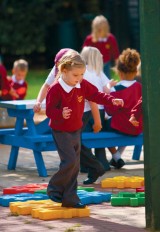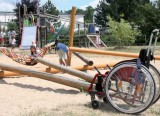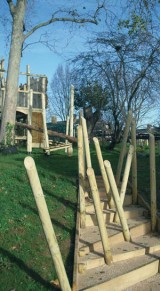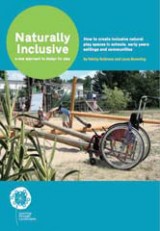Attention to detail will make your school grounds more inclusive and ensure everyone can join the fun, says Learning Through Landscapes...
 Despite best efforts, school grounds don’t often cater for all children and their specific needs. Disabled children are frequently excluded from opportunities to play. In addition, parents and carers of children with complex needs are less satisfied with play spaces than other parents, and children are unhappy with a space if they cannot play with their disabled friends.
Despite best efforts, school grounds don’t often cater for all children and their specific needs. Disabled children are frequently excluded from opportunities to play. In addition, parents and carers of children with complex needs are less satisfied with play spaces than other parents, and children are unhappy with a space if they cannot play with their disabled friends.
Making a space more inclusive means paying attention to detail. A special school has reported, for example, that a lack of understanding from the designer resulted in features that weren’t usable – stepping/balance logs that were not wide enough and obstructed wheelchair users; a shade structure that failed to provide effective shelter; and ground surface patterns and features that caused confused wayfinding.
The following suggestions focus on some of the details that can create more inclusive play areas, providing the necessary balance between fast and slow, noisy and quiet, high and low, and enclosed and open spaces.
 For many children, the chance to climb provides a strong incentive to be active. It also offers them the chance to demonstrate persistence and achieve a personal objective.Often changes in level can be more important than height. A structure that leads to a dead end can be boring, but getting to a level and coming back down via different routes retains interest. Schools can provide more inclusive climbing activities by:
For many children, the chance to climb provides a strong incentive to be active. It also offers them the chance to demonstrate persistence and achieve a personal objective.Often changes in level can be more important than height. A structure that leads to a dead end can be boring, but getting to a level and coming back down via different routes retains interest. Schools can provide more inclusive climbing activities by:
• Balancing the number of climbing opportunities with lowlevel and ground-level challenges
•Adding features to the lower parts of structures, or rock scrambles for smaller or less able children so they can join the fun without climbing to the top
• Encouraging progression with structures ranging in height •Adding value to existing structures with modular resources, such as tubes to talk through and ropes and pulleys to help children work their way along or to transport materials.
• Providing a variety of up and down structures. Children with good upper body strength can pull themselves up well-designed ramps and/or low-incline nets.
Tip
Large cardboard boxes make great temporary retreats or play spaces for smaller children. Lining the boxes with different fabrics can offer a range of tactile experiences.
Calm areas can be high or low stimulus; a place filled with plants to activate the senses or a retreat from the crowd.
These areas can be more communication friendly, stimulating speech and language development. They can also be helpful for anger management or as a place to escape from stress.
Some children find it difficult to read body language and use movements such as rocking or pacing to reduce stress. Without somewhere quiet outdoors to retreat to, children may resort to using the toilets for security and privacy. For them, social interaction is work, not play, and sensory overload can lead to tuning out. Similarly, for children made anxious by the unfamiliar, a quiet retreat can be a haven.
Understanding from practitioners can be more important to these children than equipment, but thoughtful design can also have a positive effect on their wellbeing. If it provides for their needs, a space can help them make sense of the world and relate to other people. Here are some ideas for creating calm retreats:
• A simple area of open grass has great value as a calm and sensory feature. For wheelchair users who don’t get out of their chair it is important that suitable pathways to it are available; even though others may be happier joining their friends and crawling along mown pathways.
• Calm spaces can still offer stimulating learning and play opportunities. Mastering a skill or completing a task can be an individual challenge. For example, you could offer finger mazes with features that can be manipulated by hands, feet or even the head.
• Small, low stimulus areas with restricted views are ideal for children who would like to turn their back on the world for a while and retreat into a safe place. Similarly, a simple space for one person with tactile features or cushioning could offer refuge to children who need to feel close physical contact.
 • Children wearing hearing aids may find windy sites very difficult. This can be mitigated through the use of planted windbreaks, or visually permeable screens. At the same time, the microclimate of the site will become more comfortable for all users.
• Children wearing hearing aids may find windy sites very difficult. This can be mitigated through the use of planted windbreaks, or visually permeable screens. At the same time, the microclimate of the site will become more comfortable for all users.
Tip
Getting out of their wheelchair can help some children keep their hips flexible. Structures and activities that encourage this may reduce the need for future operations.
 Many children will naturally use their creativity and imagination during play activities, and will respond to environments to create ever-changing scenarios and role-play situations. Other children may find it harder to use their imagination, or may take a different approach to creativity. For some children activities such as filling plant pots, sweeping leaves, washing outdoor furniture and watering plants are likely to be enjoyable real world tasks. Good design, resourcing and supportive practice provides for all children. Try these ideas for supporting inclusive, imaginative play:
Many children will naturally use their creativity and imagination during play activities, and will respond to environments to create ever-changing scenarios and role-play situations. Other children may find it harder to use their imagination, or may take a different approach to creativity. For some children activities such as filling plant pots, sweeping leaves, washing outdoor furniture and watering plants are likely to be enjoyable real world tasks. Good design, resourcing and supportive practice provides for all children. Try these ideas for supporting inclusive, imaginative play:
• Install simple structures and offer props to stimulate children to create their own fantasy worlds – for example, decks on different levels can become a pirate ship, a house or a shop.
• Natural loose parts – from logs and tyres to collections of branches, shells or pebbles – add a valuable and cost-effective dimension to play
• Cut branches, especially from plants such as dogwood or willow, offer den making and textile weaving materials.
• Avoid reducing the play value of a natural space through excessive tidiness. Fallen leaves and weeds around a play space can be a positive thing. Remember how much fun it was to jump into a pile of dried leaves?
• Encourage independent play for children with visual impairments by ensuring tools and resources are easy to find.
Tip
Den-making and squeezing through close planting can be a developmental experience for those children that need sensory input to tell them about body position.
 Every school has children with a diverse range of physical, behavioural and emotional needs. Yet not all children have their needs addressed through the design and use of the school’s grounds. Naturally Inclusive, the new publication from Learning through Landscapes, presents the small but vital changes that can be made outdoors so all children can enjoy exciting and challenging outdoor play. It includes:
Every school has children with a diverse range of physical, behavioural and emotional needs. Yet not all children have their needs addressed through the design and use of the school’s grounds. Naturally Inclusive, the new publication from Learning through Landscapes, presents the small but vital changes that can be made outdoors so all children can enjoy exciting and challenging outdoor play. It includes:
• A design book with inspirational pictures and insights plus cost conscious and easy to achieve ideas for your outdoor space
• A training guide to help you develop your observational skills and achieve excellence in inclusive outdoor natural play practice
• A 50 minute DVD showing inclusive play in action.
Visit ltl.org.uk for more details, or call 01962 845811.
Mary Jackson is Development Manager at Learning Through Landscapes. A former teacher and qualified landscape architect, she leads on LTL’s continued SEN work.
Use scaffolding to wean children off high levels of TA support
Ace-Kitchen-Manager
